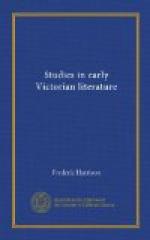A striking example of Thackeray’s unrivalled powers of imitation may be seen in the letters which are freely scattered about his works. No one before or since ever wrote such wonderfully happy illustrations of the epistolary style of boy or girl, old maid or illiterate man. There never were such letters as those of George Osborne in Vanity Fair—that letter from school describing the fight between Cuff and Figs is a masterpiece—the letters of Becky, of Rawdon, of Amelia—all are perfect reproductions of the writer, as are scores of letters scattered up and down the twenty-six volumes. Nor must we omit, as part of the style, the author’s own illustrations. They are really part of the book; they assist us to understand the characters; they are a very important portion of the writer’s method. None of our great writers ever had this double instrument: and Thackeray has used it with consummate effect. The sketches in Vanity Fair and in Punch, especially the minor thumb-nail drolleries, are delightful—true caricatures—real portraits of character. It is true they are ill drawn, often impossible, crude, and almost childish in their incorrectness and artlessness. But they have in them the soul of a great caricaturist. They have the Hogarthian touch of a great comic artist.
One is tempted to enlarge at length on the merits of Thackeray’s style, because it is in his mastery over all the resources of the English language that he surpasses contemporary prose writers. And it is a mastery which is equally shown in every form of composition. There is a famous bit of Byron’s about Sheridan to the effect that he had written the best comedy, made the finest speech, and invented the drollest farce in the English language. And it is hardly extravagant to say of Thackeray that, of all the Englishmen of this century, he has written the best comedy of manners, the best extravaganza, the best burlesque, the best parody, and the best




